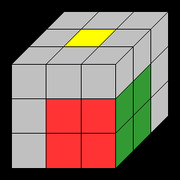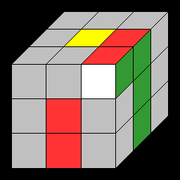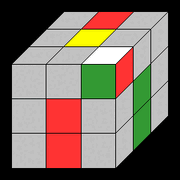F2L is used in the Fridrich method, to solve the first two layers simultaneously. Before you begin executing F2L, you should have solved the white cross already.

Solved F2L.
There are two ways to execute F2L, intuitive and algorithmic. Intuitive is solving the first two layers by intuition instead of algorithms. If you learn F2L the arithmic way, you learn every single situation and a corresponding algorithm. Speedsolvers mainly use intuitive F2L, since you do not have to learn any algorithms at all. For the algorithmic way, visit www.cubewhiz.com . The intuitive way will be taught here.
The first thing you do is finding a white corner-piece, and it's corresponding edge piece. In the examples to the right, I will always use the white-green-red corner-piece and the green-red edge-piece. There are many different ways the two pieces can be found around the cube. All those situations are divided in three main groups:(then OLL will come later)
- Both pieces in top layer;

On the back side, there is a green sticker.
- One piece in the top layer;
- Both pieces not in the top layer.
All these categories have subcatogories, shown below.
Techniques[]
One technique frequently used in F2L is called hiding. What you basically do, is hiding a piece in the first two layers, so that you can rotate the top layer freely. Suppose we want to make a pair of the two pieces shown in the image above. We have to hide the cornerpiece in one of the

Two pieces paired up.
bottom layers, in order to be able to turn the top layer freely. Because we want green to meet the green sticker and red meeting the red sticker, we can only hide the cornerpiece with white on the side. How do we do that? In this example, you can turn F (of course only where there is no solved pair in position FL). Now the cornerpiece is in DFR, and you can now turn the top layer freely. Since we want to pair up the two pieces, it makes sence to turn U. Because now, after bringing the cornerpiece back up again by F', we now have a beautiful pair of pieces.
1. Both pieces in the top layer[]
Almost always, you'll find yourself in the position, in which the two pieces are in the top layer. Then, there are three subcategories:
- The same colour on top;

Two pieces with the same colour on top (red).
- Different colours on top;
- White of cornerpiece on top;
Same colour on top[]
When you have two pieces with the same colour on top, you want to pair them up. To do that, you'll need to hide the cornerpiece, with white at the side. Then, you can turn the edgepiece freely. Make sure you bring the cornerpiece back up next to the edgepiece. Now, you'll have a nice pair, like the one shown in the picture.

The position before turning R U' R'.
When you have this pair (whether it was by pairing up or not), look at the colour on top. Get the edgepiece right above the corresponding centerpiece, and hold that centerpiece at the front side. Now, there are two possible situations; the white cornerpiece can either be on the left or on the right. If it is on the left, the spot where that pair needs to go is in FR. If it is on the right, the spot is in FL. If it needs to go to the left, turn this algorithm:
L' U L
If it needs to go to the right, turn this algorithm:

The final orientation. The cornerpiece can also be in UFL.
R U' R'
Now, you should be able to get this pair in.
Different colour on top[]
To make things clear, I'll first tell you what you eventually want to have. You want to have the cornerpiece in either UFR or UFL, with white at the side. The edgepiece must be in UB. And, of course, you want to have two different colours on top. If you do not have this situation right away, you will have to hide the cornerpiece or the edgepiece. In this case, it doesn't matter which one you hide, but it the previous case, it did matter. Once you have it set up like this, hold the white piece at the side at look at the colour at the front side. Find the corresponding centerpiece, and line the two stickers up diagonally (like shown in the picture and done in step 2 of the beginner method). Then, hold this hold the diagonal line at the front face. Now, there are two possible situations. If the cornerpiece is in UFL, turn:
L' U' L
If it is in UFR though, turn:
F' U E'
Now, you will be able to get it solved.
White on top[]

White sticker on top.

The situation before.
cornerpiece we care of for this F2L situation can be in the way for turning back F, to restore the cross again). In the example we will have to turn U. Then, when the way is safe again, we can turn F now, to restore the cross again. Next, you can solve this situation the same way as explained above. Although the concept above looks very nice, when the cornerpiece and the edgepiece are separated from each other (as in the picture), there is a special trick. You do not hide the cornerpiece, but the edgepiece. First, find the colour of the edgepiece that is not on top. Then, locate the corresponding centerpiece and line up both pieces, so that you have a very nice line at the front. Now, look where the edgepiece must eventually end up (between its two corresponding centerpieces), and turn the front side, in order to NOT get it there. This might seem strange, but this makes sure an unsolved slot will come into top layer. Now, you can turn the top layer

After turning the white piece on top.
freely, and the nice thing you can do now, is turning the cornerpiece directly above the edgepiece. Now, when you turn both backup again, to restore the cross, you have automatically created a pair, which can be inserted into its slot with the algorithms above.
In the images to the right, you can see what happens. You turn F, to hide the edgepiece. Then, you turn the cornerpiece on top, by turning U, as shown in picture 2. After that, you turn F' again, to restore the cross. Simultaneously, you have created a pair, which you can easily place.
I hope this made some sense to you now, because it's very hard to explain.
One piece on top[]
When you have only one piece in the upper layer, the best thing you can usually do is doing the same as explained above to deal with the white on top situation. Note that only the first method there will work. Once you have both of them in the top layer, you can continue solving it as you normally would.
Although this always works, there are some situations where it's better to use tricks.

The edgepiece is solved.
For example, you get into the situation in which the edgepiece is already solved, as shown in the picture to the right. You would of course like to have a way to get the cornerpiece in the place under the edge piece without disturbing the edge piece. Luckily, there is one. Set everything up, so that you can place the corner piece in a place next to the place where he has to go eventually. In the picture, it's already set up like that. Next, you turn the downside, until the place where the corner piece has to go, is directly under it. Then, place it in there as normal, and turn the down face back. In the example picture, you do this: D' F U F' D.

The cornerpiece is solved.
You can also have the cornerpiece solved, and the edgepiece not solved. A similar trick can be performed. Look at the top colour of the edgepiece, and get the edgepiece above the corresponding centerpiece, as shown in the picture. Then, turn the down face, either clockwize or counter-clockwize to save the cornerpiece. Then, turn the place where the edgepiece eventually needs to go up, next to the edgepiece. Next, turn the edgepiece into that position and turn the edgepiece back down. At last, turn the cornerpiece back.
In the image, you would have to do the following: D (to save the cornerpiece) R (to bring up the eventual place of the edgepiece) U' (to get the edgepiece in that place) R' (to bring the edgepiece down) D' (to get the cornerpiece back).
No pieces in the top layer[]
When none of the pieces is in the top layer, I would advice you to first look for another pair. Only if you do not have any choice, you'll have to get both pieces out of the lower layers. That can be done like explaned above. Because this is a very uncommon situation, I will not cover it here. (Really, I think that there is less than 0,01% chance of that it'll happen.)
I know that explaining F2L is very difficult. I've really tried my best to explain the basic things of F2L. If you still have problems with F2L, which I can imagine, please leave a comment below.